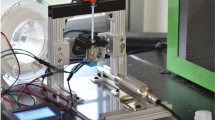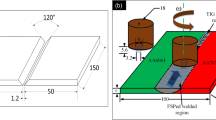Abstract
With the proposal of the average temperature concept, the target of this study is to determine the appropriate dimensional profile and heat input for butt welded joints. Meanwhile, inherent deformation as the cause of welding distortion was examined to confirm the dimensional profile and heat input of welded joints for reliable welding experiments. First, butt welding experiment and measurement of out-of-plane welding distortion were conducted. The effect of length and width of welded joint on longitudinal shrinkage force was numerically considered and examined with a series of thermal elastic plastic finite element computations, where the mechanism of this behavior was clarified with average temperature. The case of heat input increasing was also examined with average temperature, which can be considered as the identical heat input for plate width decreasing. Moreover, the difference between theoretical and computational approaches to evaluate longitudinal shrinkage force was perfectly clarified with the concept of average temperature, and dimensional profile and heat input of butt welded joints were suggested.


















Similar content being viewed by others
References
Satoh, K., Ueda, Y., & Fujimoto, J. (1979). Welding distortion and residual stresses. Tokyo: Sanpo Publication.
Ueda, Y., & Yuan, M. G. (1993). Prediction of residual stress in butt welded plates using inherent strain. Journal of Engineering Materials and Technology of ASME, 115, 417–423.
Masubuchi, K. (1980). Analysis of welded structures: Residual stresses, distortion and their consequences. Oxford: Pergamon Press.
Vasantharaja, P., Vasudevan, M., & Palanichamy, P. (2015). Effect of welding processes on the residual stress and distortion in type 316LN stainless steel weld joints. Journal of Manufacturing Processes, 19, 187–193.
Fricke, W., & Zacke, S. (2014). Application of welding simulation to block joints in shipbuilding and assessment of welding-induced residual stresses and distortions. International Journal of Naval Architecture and Ocean Engineering, 6, 459–470.
Wang, J. C., Rashed, S., Murakawa, H., & Luo, Y. (2013). Numerical prediction and mitigation of out-of-plane welding distortion in ship panel structure by elastic FE analysis. Marine Structures, 34, 135–155.
Wang, J. C., Yin, X., & Murakawa, H. (2013). Experimental and computational analysis of residual buckling distortion of bead-on-plate welded joint. Journal of Materials Processing Technology, 213(8), 1447–1458.
Wang, J. C., Rashed, S., & Murakawa, H. (2014). FE analysis of buckling behavior caused by welding in thin plates of high tensile strength steel. Journal of Materials Engineering and Performance, 23(12), 4358–4365.
Wang, X., Sun, Q., Zheng, Z., & Di, H. (2017). Microstructure and fracture behavior of laser welded joints of DP steels with different heat inputs. Materials Science and Engineering A, 699, 18–25.
Adamczuk, P. C., Machado, I. J., & Mazzaferro, J. A. M. (2017). Methodology for predicting the angular distortion in multi-passbutt-joint welding. Journal of Materials Processing Technology, 240, 305–313.
Li, Y., Zhao, Y., Li, Q., Wu, A. P., Zhu, R., & Wang, G. (2017). Effects of welding condition on weld shape and distortion in electron beam welded Ti2AlNb alloy joints. Materials and Design, 114, 226–233.
Gadallah, R., Tsutsumi, S., Hiraoka, K., & Murakawa, H. (2015). Prediction of residual stresses induced by low transformation temperature weld wires and its validation using the contour method. Marine Structures, 44(4), 232–253.
Wang, J. C., Rashed, S., Murakawa, H., & Shibahara, M. (2011). Investigation of buckling deformation of thin plate welded structures. In Proceeding of 21st international society of ocean and polar engineering, USA Hawaii (pp. 125–131).
Ma, N., Wang, J. C., & Okumoto, Y. (2016). Out-of-plane welding distortion prediction and mitigation in stiffened welded structures. The International Journal of Advanced Manufacturing Technology, 84(5), 1371–1389.
Ueda, Y., Murakawa, H., & Ma, N. (2012). Welding deformation and residual stress prevention. Oxford: Butterworth Heinemann Publishing.
Deng, D., Murakawa, H., & Liang, W. (2008). Prediction of welding distortion in a curved plate structure by means of elastic finite element method. Journal of Materials Processing Technology, 203(1-3), 252–266.
Wang, J. C., Ma, N., Murakawa, H., Teng, B. G., & Yuan, S. J. (2011). Prediction and measurement of welding distortion of a spherical structure assembled form multi thin plates. Materials and Design, 32(10), 4728–4737.
Wang, J. C., Shibahara, M., Zhang, X. D., & Murakawa, H. (2012). Investigation on twisting distortion of thin plate stiffened structure under welding. Journal of Materials Processing Technology, 212(8), 1705–1715.
Wang, J. C., Ma, N., & Murakawa, H. (2015). An efficient FE computation for predicting welding induced buckling in production of ship panel structure. Marine Structure, 41, 20–52.
White, J. D., Leggatt, R. H., & Dwight, J. B. (1980). Weld shrinkage prediction. Welding and Metal Fabrication, 11, 587–596.
Luo, Y., Lu, H. Y., Xie, L., & Zhu, Z. F. (2004). Concept and evaluated method of tendon force. Marine Technology, 2004(4), 35–37.
Wang, J. C., Zhou, H., Zhao, H., Zhou, F. M., & Ma, N. (2017). Comparative study on evaluation of tendon force for welding distortion prediction in thin plate fabrication. China Welding (English Edition), 26(3), 1–11.
Luo, Y., Murakawa, H., & Ueda, Y. (1997). Prediction of welding deformation and residual stress by elastic FEM based on inherent strain (first report): Mechanism of inherent strain production. Transactions of JWRI, 26(2), 49–57.
Acknowledgements
The author appreciates the financial support by National Natural Science Foundation of China (Grant No. 51609091) and the Open Research Fund of Key Laboratory of Jiangsu Province for Advanced Design and Manufacture Technology of Ship, and also appreciates the relevant staff in research group of Prof. Xianqing Yin (Xi’an Jiao Tong University) for carrying out the experiments and measurements.
Author information
Authors and Affiliations
Corresponding author
Additional information
Publisher's Note
Springer Nature remains neutral with regard to jurisdictional claims in published maps and institutional affiliations.
Rights and permissions
About this article
Cite this article
Wang, J. Determination of Dimensional Profile and Heat Input of Welded Joints with Average Temperature. Int. J. Precis. Eng. Manuf. 20, 651–662 (2019). https://doi.org/10.1007/s12541-019-00071-7
Received:
Revised:
Accepted:
Published:
Issue Date:
DOI: https://doi.org/10.1007/s12541-019-00071-7




